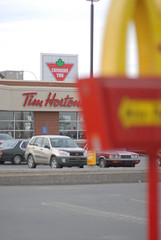The gist: Talking about smart city planning in terms of our core values — quality of life, family, freedom, choices — and emphasizing convenience and community character will set the stage for broad support of policies that make sure we build family-friendly and climate-friendly places to live.
Talking Points: connecting our core values to policies that promote healthy, climate‑friendly places to live–and limit sprawl
We know in our guts that more time in our cars, more and more money on gas, and more pavement over farmland is making our lives worse, not better. But how will Americans decide if certain policies to promote smart growth are good or bad? According to an extensive public opinion research project and communications toolkit produced by the Biodiversity Project, people will ask if community planning and land use policy is consistent with their values — personal decisions about how they want to live, how they see their future, what they believe is common sense, and what they believe is right and wrong.
Communications experts recommend stressing the benefits of sprawl-curbing measures — walkable, healthy, livable communities, revitalized downtowns, transportation choices and convenience, less time in traffic, protected open spaces and local farmland. These recommendations are reinforced by current opinion research examining American’s hopes and dreams for their communities. In particular, we looked at the National Association of Realtors and Smart Growth America’s 2007 community planning survey. We also recommend Smart Growth America’s continuing research.
Flashcard Tips:
Freedom
Choices and Convenience
Character, Not Cookie Cutter!
Freedom
Freedom is about spending our time and our money the way we want to. And uncontrolled sprawl costs us dearly in both.
Nobody wants to spend more time commuting each year than we spend on vacation! But many of us are doing just that. And most of us know in our hearts that out-of-control sprawl is not enhancing our quality of life — in fact we see that it’s making our lives more difficult, reducing our transportation choices, and swallowing up our time as fast as it swallows up our precious farmland, open spaces, and favorite places. Living the good life is about time with friends and family and time enjoying the natural places around us, not more and more time trapped in our cars.
Many Americans spend more time in their car commuting to and from work than they do on vacation. Worse, we’re paying a good chunk of our income just to get ourselves to work. Already in 2005 — when gas prices were far lower than today — the average US Federal employee, who commuted five days a week spent $10,580 annually — just to get to work. On average, this amounted to 16 percent of their after-tax income. And this was way back in 2005 when fuel prices weren’t through the roof as they are today.
Building good communities to live in makes financial sense too: studies find home buyers are willing to pay a premium, ranging from $5,000 to $30,000 for residences in mixed-use, higher-density, pedestrian-oriented developments relative to otherwise similar homes in surrounding sprawling subdivisions.
More than 70 percent of surveyed Americans are concerned about how growth and development affects global warming. The Smart Growth America / National Association of Realtors survey showed Americans expressing strong support for bold measures to combat climate change. Nearly nine in 10 believe that new communities should be built so people can walk more and drive less; cars, homes and buildings should be required to be more energy efficient; and public transportation should be improved and made more available.
Choices and Convenience
 Sitting in traffic is not our idea of freedom! With rising gas prices, choices and convenience are key. And more than half of Americans (53 percent) say they would use transit if it were easily accessible from their homes and work.
Sitting in traffic is not our idea of freedom! With rising gas prices, choices and convenience are key. And more than half of Americans (53 percent) say they would use transit if it were easily accessible from their homes and work.
Three fourths of Americans believe that being smarter about development and improving public transportation are better long-term solutions for reducing traffic congestion than building new roads, according to a survey by the National Association of Realtors and Smart Growth America. Only one in five said building new roads was the answer.
Suburban households drive 31 percent more than their urban counterparts, and western households drive 35 percent more miles than northeastern households.
Nearly seven in ten Americans support local policies to encourage mixed urban development — changing their city or town’s zoning rules to require that neighborhoods have a mix of housing, offices, industry, schools, and stores close together to encourage walking and decrease the need for a car. Again, while this kind of policy should provide environmental benefits, many Americans may also support this approach as a way to make cities more liveable, convenient, and as a means to build and maintain a sense of community.
More than half of Americans — 53 percent — say they would be willing to use mass transit if it were easily accessible from their homes and where they work, and the pressure of rising gas prices may make it an even more attractive alternative. Two in three (65 percent) said the rising price of gasoline makes them more likely to consider using mass transit and 44 percent would be willing to pay higher taxes if they knew all the added taxes were being spent on improving or creating public transportation where they live.
Character, Not Cookie Cutter!
Old MacDonald’s farm or new McDonalds restaurants? Home towns or Home Depots? We love our unique corner of the world, its quirks, its charm, its distinctiveness. We don’t want every city in the country to look exactly alike, filled with all the same stores and all the same restaurants.
“I just don’t want my home town to look like any other place in the country, with all the same shops and all the same miles and miles of blacktop.” — Focus group participant, Spokane, Washington, 2007.
Majorities of Americans are concerned about the loss of their communitiy’s individual character to out-of-control growth (64 percent), loss of historic landmarks (66 percent), and loss of local farmland to sprawl and strip-malls (72 percent).
The Canadian Perspective:
Urbanites in Toronto, Vancouver, Calgary, Edmonton, Regina, Saskatoon and Winnipeg agree that protecting farmland and natural areas adjacent to cities is a good idea and most agree that green space is an essential ingredient for quality of life.
Majorities of Canadians define the ideal place to live in similar terms: The ideal town or city has high quality education, a thriving economy, green spaces, good transportation and affordable housing. Urban Canadians clearly believe that sustainability can be achieved without economic compromise. Almost 80 percent agree that “we can develop cities and towns that are economically prosperous and environmentally friendly without having to compromise one goal for another.”
All about Sprawl: Sightline researchers write about smart land use and healthy cities
Sprawling Alone
Does sprawl really erode social relationships?
Sprawl Killing Puget Sound
Complete, compact communities are the solution.
Charming 3-bedroom, 2 bath — with only 5 pounds of weight gain a year
Does sprawl cause obesity, or vice versa?
Does Sprawl Shorten Our Lives?!
New study finds that sprawl ages you.
Density We Can Afford
Can density solve the problem of housing affordability?
Polling Portland on Growth
Portland residents want to preserve farms, forests, and property rights.









